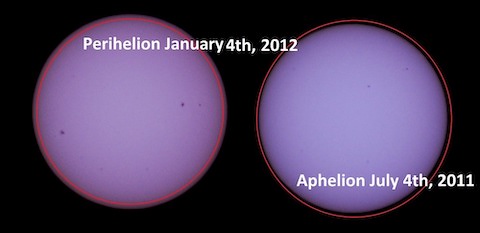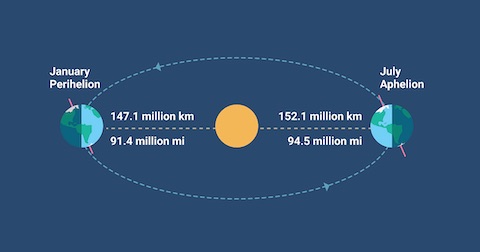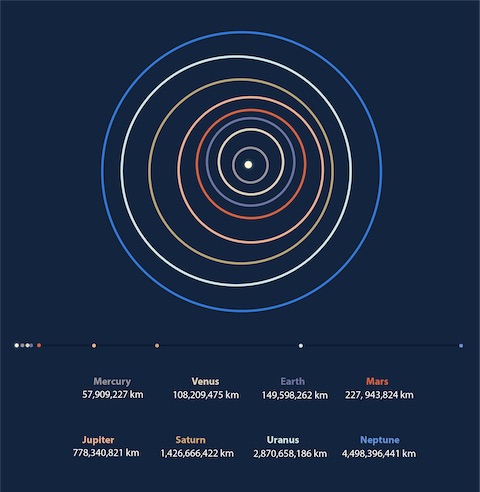
Credit: David Dickinson, Universe Today
Each winter in the Northern Hemisphere, it feels like Earth is drifting farther away from the warmth of the Sun.
In fact, it’s just the opposite. When we measure the size of the Sun in our sky, we find that it actually appears 3.4% larger in winter—because it’s 3.4% closer.
More than 3 million miles closer. The Sun is about 95 million miles away in summer, but just 92 million in winter.
And this is because Earth’s orbit is elliptical, with Earth following the closer part of its path during the northern winter.
You’d expect the nearer Sun to provide more solar energy to our planet and you’d be right: almost 7% more.
But its effect is greatly minimized by the 23-degree tilt of Earth’s axis, turning the Northern Hemisphere away from the Sun in the winter.
At the same time, in the Southern Hemisphere summer, that extra solar energy is mostly absorbed by the huge southern oceans.
The effects may be minor today, but that won’t always be the case.
The gravity of Saturn and Jupiter pulls Earth through a long cycle of orbital stances, from nearly circular, to more elliptical.
We’re now as close to circular as our orbit ever gets. In about 200,000 years, we’ll be at our elliptical maximum.
Then, Earth will receive 23% more solar radiation when closest to the Sun. This varying solar energy will have significant impacts on weather and climate.
Background
Synopsis: Earth’s year is defined by its annual voyage around the Sun. For part of the year Earth is closer to the Sun, and for part of the year, Earth is farther from the Sun. But if you live in the Northern Hemisphere, you might be surprised to learn that in the winter, Earth is 3 million miles (5 million km) closer to the Sun than in summer! This is called the perihelion and occurs this year on January 2nd at 7:50 AM Central Standard Time.
- Earth’s orbit is almost circular, but not quite.
- Earth’s average distance from the Sun is 92.96 million miles (149.60 million km).
- But Earth’s orbit is slightly elliptical, so the actual distance ranges from 91.4 to 94.5 million miles (147.1 to 152.1 million km, or 0.9833 to 1.0167 AU).
- The closest approach to the Sun is called the perihelion (in ancient Greek, peri- means “close” and -helios means “sun”) and the farthest point is called the aphelion (apo- means “far”). These events are known as apsides, and their specific timing varies slightly year to year depending on variations in Earth’s orbit.
- Coincidentally, perihelion and aphelion occur about 2 weeks after the respective solstices, but these two astronomical events are unrelated.
- The timing of Earth’s apsides shifts progressively later by about 1 day every 58 years. In about 10,000 years, the perihelion will occur during the Northern Hemisphere's summer.

Credit: TimeandDate.com
- Deviation from a perfect circle is expressed by a property known as eccentricity. An orbit with an eccentricity of 0.0 is circular, whereas orbits with larger and larger eccentricity are more and more elliptical. We can also think of eccentricity values as percentages from 0% to 100%.
- Today’s, Earth's orbital eccentricity is just 1.67%—very close to zero. However, that eccentricity is currently decreasing imperceptibly, making Earth's path more and more circular.
- Jupiter and Saturn tug on Earth, causing its orbit to slowly oscillate from almost a perfect circle (e = 0.0055%) to a slightly more elliptical shape (e = 6.79%) then back to a circle again. This cycle takes 413,000 years to repeat.
- So why is January cold and wintery in the Northern Hemisphere if that’s when we are actually closer to the Sun?
- With its current eccentricity, Earth is 3.4% closer to the Sun in January than in July, and during the perihelion, the Sun appears 3.4% larger from Earth.
- Being 3.2 million miles (5.1 million km) closer to the Sun in January compared to July seems like it should make a large difference on climate.
- But because Earth’s orbit is so close to circular, its eccentricity doesn’t have much impact on surface temperatures—incoming solar irradiation only increases by 6.8% during the perihelion.
- Earth’s added closeness to the Sun during Northern Hemisphere winters may make the season’s cold weather slightly milder. But the effect of that slight increase in irradiation pales in comparison with the impact of the 23.5-degree tilt of Earth’s rotational axis. It’s the tilt of the Earth’s axis that affects our seasons.
- Six months later, the heat of northern summers may be tempered somewhat because they occur during the aphelion when the sun is most distant from Earth.

Credit: Phoenix7777 (CC BY-SA)
- Why then aren’t summers in the Southern Hemisphere unbearably hot, if the Earth’s southern end is tilted toward the Sun at the same time we are closest to the Sun’s heat?
- The Southern Hemisphere has a smaller amount of landmass, so much of the Sun’s added intensity during this time is absorbed by the large southern oceans.
- Six months later, the combined effect of the decrease in solar irradiation and the arrival of winter is buffered by these same vast oceans, which carry heat.
- Today, we can’t really detect the impact of the apsides on Earth thanks to the buffering effect of the oceans in the Southern Hemisphere and the cancelling out effect of the opposing seasons in the Northern Hemisphere.
- But in ~10,000 years, perihelion will occur during Northern Hemisphere summers, increasing insolation by 6.8% during the already hottest time of the year. This will happen because of the wobble of Earth’s axis known as precession.
- One interesting corollary: when Earth is closer to the Sun during perihelion, its orbital velocity is faster, so though orbital eccentricity doesn’t impact the intensity of the seasons much ,it does impact their length.
- Winter in the Northern Hemisphere is about 5 days shorter than summer, and autumn is about 3 days shorter than spring.
- This is reversed in the Southern Hemisphere.

Credit: SpaceFacts.com
- Earth’s current circular orbit helps protect it from the extremes seen on other planets in our solar system, keeping our climate stable enough to support life and human civilizations.
- In our solar system, only Neptune (0.86%) and Venus (0.68%) have more circular orbits than Earth, whereas Mars (9.34%), Mercury (20.56%), and Pluto (24.88%) orbits are the most elliptical.
- Poor Pluto has it the worst. With an eccentricity of nearly 25%, its incoming solar irradiation varies more than 64% during its year, which takes 250 Earth years to complete.
- But Earth’s orbit won’t remain circular forever. Every 413,000 years, Earth’s orbit reaches its maximum eccentricity of 6.79. The gravitational pull of Saturn and Jupiter causes this cyclical shift.
- We are currently at the opposite end of the cycle, with Earth’s orbit approaching circular, so maximum eccentricity is more than 200,000 years in the future. At that point, Earth’s annual solar irradiation variance would more than triple—from 6.8% to around 23%—significantly impacting our planet’s temperature and weather.
- We can get an idea of what that would be like from Mars, which currently has an orbit that is elliptical enough for insolation to vary by about 31% between its perihelion and its aphelion.
- Mars has an axial tilt of 25.19 degrees, so it experiences seasons like Earth does.
- Also like Earth, its northern hemisphere is tilted away from the Sun during its closest approach to the Sun and toward the Sun during its farthest approach, creating milder northern winters and summers.
- But unlike Earth, Mars’ southern hemisphere has no buffering oceans, so southern summers are sizzling, with intense winds that tear up the planet’s surface and create wild dust storms that kick dust up into the planet’s atmosphere. Mars’ intense southern summers are 30 days shorter than winters as Mars picks up speed on its closer approach to the Sun.
- Conversely, southern winters on Mars are so frigid that the southern polar ice cap on Mars grows twice as far from the pole each year compared to the northern ice cap.

